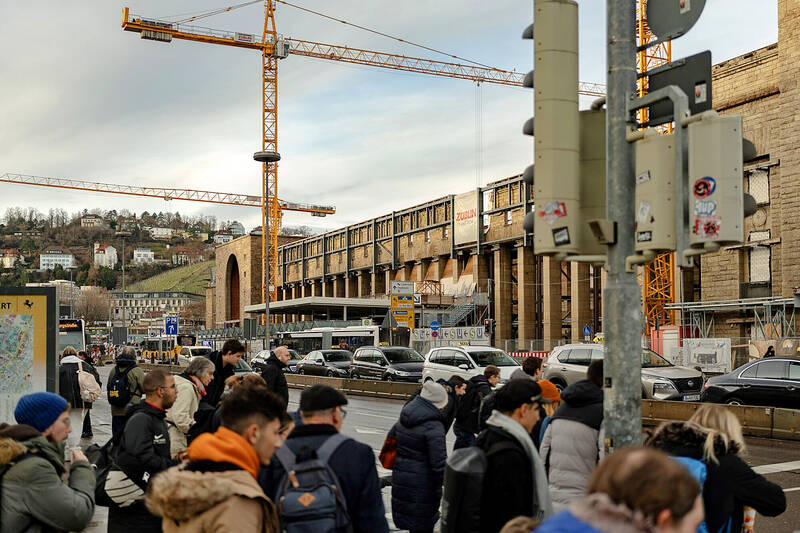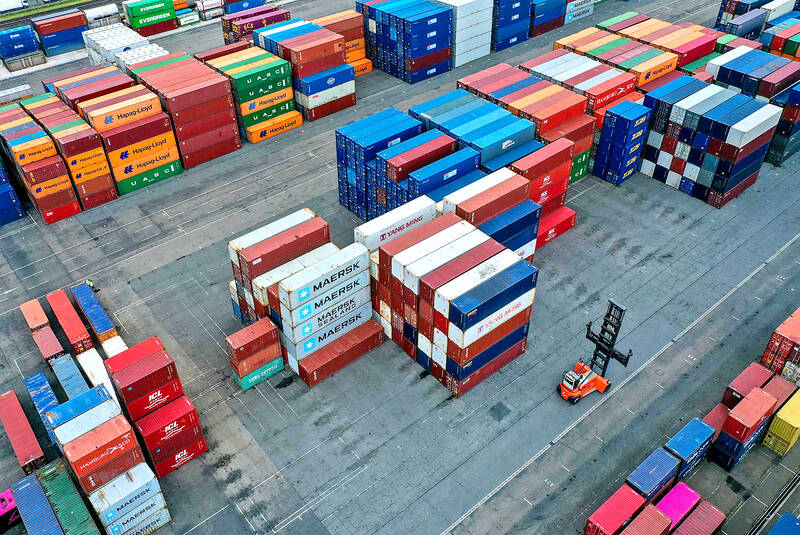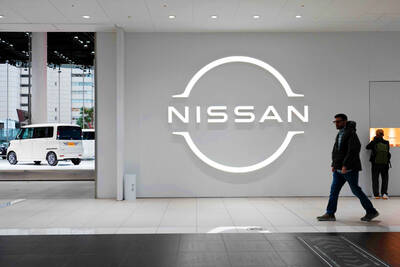In a cavernous production hall in Dusseldorf last fall, the somber tones of a horn player accompanied the final act of a century-old factory.
Amid the flickering of flares and torches, many of the 1,600 people losing their jobs stood stone-faced as the glowing metal of the plant’s last product — a steel pipe — was smoothed to a perfect cylinder on a rolling mill. The ceremony ended a 124-year run that began in the heyday of German industrialization and weathered two world wars, but could not survive the aftermath of the energy crisis.
There have been numerous iterations of such finales over the past year, underscoring the painful reality facing Germany: its days as an industrial superpower might be coming to an end.

Photo: Bloomberg
Manufacturing output in Europe’s biggest economy has been trending downward since 2017, and the decline is accelerating as competitiveness erodes.
“There’s not a lot of hope, if I’m honest,” said Stefan Klebert, chief executive officer of GEA Group AG, a supplier of manufacturing machinery that traces its roots to the late 1800s. “I am really uncertain that we can halt this trend. Many things would have to change very quickly.”
The underpinnings of Germany’s industrial machine have fallen like dominoes. The US is drifting away from Europe and is seeking to compete with its transatlantic allies for climate investment. China is becoming a bigger rival and is no longer an insatiable buyer of German goods. The final blow for some heavy manufacturers was the end of huge volumes of cheap Russian natural gas.

Photo: AFP
Alongside global volatility, political paralysis in Berlin is intensifying long-standing domestic issues such as creaking infrastructure, an aging workforce and the snarl of red tape.
Germany’s education system, once a strength, is emblematic of a long-term lack of investment in public services. The Ifo research institute estimates that declining math skills will cost the economy about 14 trillion euros (US$15 trillion) in output by the end of the century.
In some cases, the industrial downshift is taking place in small steps like scaling back expansion and investment plans. Others are more evident like shifting production lines and trimming staff. In extreme instances — like Vallourec SACA’s pipe plant, once part of fallen industrial giant Mannesmann AG — the consequence is permanent closure.
Germany still has an enviable roster of small, agile manufacturers, and the Bundesbank and others reject the notion that full-blown deindustrialization is anywhere close. But with reforms stalled, it’s unclear what will slow the decline.
“We are no longer competitive,” German Minister of Finance Christian Lindner said at a Bloomberg event earlier this month. “We are getting poorer because we have no growth. We are falling behind.”
Fading industrial competitiveness threatens to plunge Germany into a downward spiral, Michelin SCA northern Europe head Maria Rottger said. The French tiremaker is shutting two of its German plants and downsizing a third by the end of next year in a move that will affect more than 1,500 workers. US rival Goodyear Tire & Rubber Co has similar plans for two facilities.
“Despite the motivation of our employees, we have arrived at a point where we can’t export truck tires from Germany at competitive prices,” she said in a recent interview. “If Germany can’t export competitively in the international context, the country loses one of its biggest strengths.”
Other examples of decline surface regularly. GEA Group is closing a pump factory near Mainz in favor of a newer site in Poland. Autoparts maker Continental AG announced plans in July last year to abandon a plant that makes components for safety and brake systems. Rival Robert Bosch GmbH is in the process of slashing thousands of workers.
The energy crisis in the summer of 2022 was a major catalyst. While worst-case scenarios like freezing homes and rationing were avoided, prices remain higher than in other economies, which adds to costs from higher wages and regulatory complexity.
Germany’s sluggish bureaucracy also is not keeping pace, even when companies are prepared to invest. GEA installed solar capacity at a factory in the western German town of Oelde, where it makes equipment that can separate cream from milk. It applied for permits to feed in the power in January last year, two months before starting construction and is still waiting for approval — nearly two years after initiating the project.
Furthermore, China is now causing trouble for Germany in a number of ways. On top of its strategic shift into advanced manufacturing, a slowdown of the Asian superpower’s economy is sapping demand for German goods even further. At the same time, cheap competition from China is worrying industries key for Germany’s climate transition — and not just electric cars.
Germany’s headwinds require adaptation. For EBM-Papst, a producer of fans and ventilators, the industrial crisis meant acquiring a struggling supplier. And to stay nimble, the company shifted production to components for heat pumps and data centers and away from the auto sector. It’s also looking to move some administrative tasks to eastern Europe or India.
“It’s not just energy,” EBM-Papst CEO Klaus Geisdorfer said in an interview. “It’s also staff availability in Germany, which is now very tense.”
Within a decade, the working-age population will be too small to keep the economy functioning as it does today, he added.

Nissan Motor Co has agreed to sell its global headquarters in Yokohama for ¥97 billion (US$630 million) to a group sponsored by Taiwanese autoparts maker Minth Group (敏實集團), as the struggling automaker seeks to shore up its financial position. The acquisition is led by a special purchase company managed by KJR Management Ltd, a Japanese real-estate unit of private equity giant KKR & Co, people familiar with the matter said. KJR said it would act as asset manager together with Mizuho Real Estate Management Co. Nissan is undergoing a broad cost-cutting campaign by eliminating jobs and shuttering plants as it grapples

PERSISTENT RUMORS: Nvidia’s CEO said the firm is not in talks to sell AI chips to China, but he would welcome a change in US policy barring the activity Nvidia Corp CEO Jensen Huang (黃仁勳) said his company is not in discussions to sell its Blackwell artificial intelligence (AI) chips to Chinese firms, waving off speculation it is trying to engineer a return to the world’s largest semiconductor market. Huang, who arrived in Taiwan yesterday ahead of meetings with longtime partner Taiwan Semiconductor Manufacturing Co (TSMC, 台積電), took the opportunity to clarify recent comments about the US-China AI race. The Nvidia head caused a stir in an interview this week with the Financial Times, in which he was quoted as saying “China will win” the AI race. Huang yesterday said

TEMPORARY TRUCE: China has made concessions to ease rare earth trade controls, among others, while Washington holds fire on a 100% tariff on all Chinese goods China is effectively suspending implementation of additional export controls on rare earth metals and terminating investigations targeting US companies in the semiconductor supply chain, the White House announced. The White House on Saturday issued a fact sheet outlining some details of the trade pact agreed to earlier in the week by US President Donald Trump and Chinese President Xi Jinping (習近平) that aimed to ease tensions between the world’s two largest economies. Under the deal, China is to issue general licenses valid for exports of rare earths, gallium, germanium, antimony and graphite “for the benefit of US end users and their suppliers

Dutch chipmaker Nexperia BV’s China unit yesterday said that it had established sufficient inventories of finished goods and works-in-progress, and that its supply chain remained secure and stable after its parent halted wafer supplies. The Dutch company suspended supplies of wafers to its Chinese assembly plant a week ago, calling it “a direct consequence of the local management’s recent failure to comply with the agreed contractual payment terms,” Reuters reported on Friday last week. Its China unit called Nexperia’s suspension “unilateral” and “extremely irresponsible,” adding that the Dutch parent’s claim about contractual payment was “misleading and highly deceptive,” according to a statement